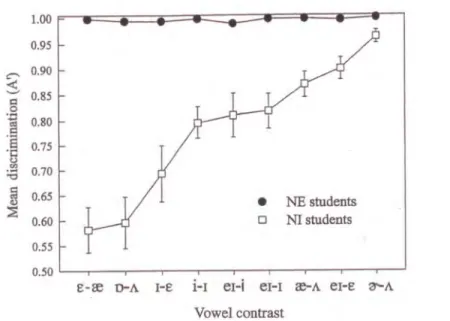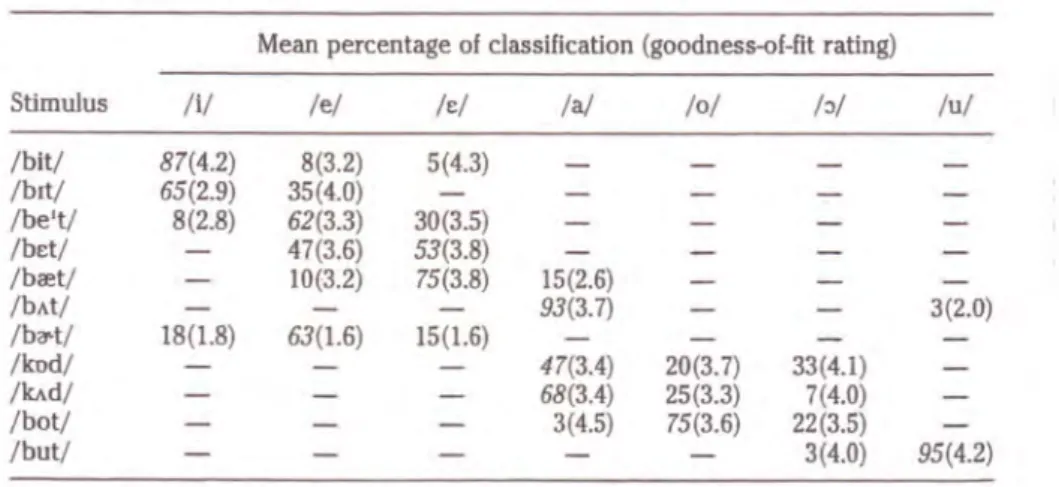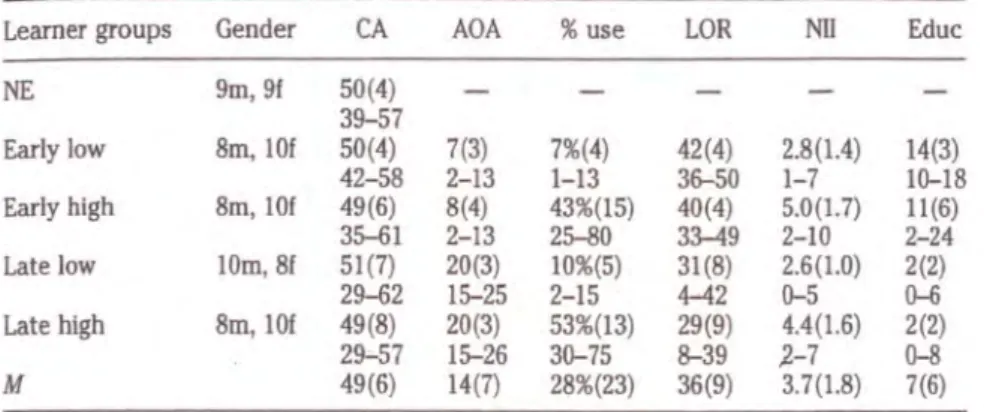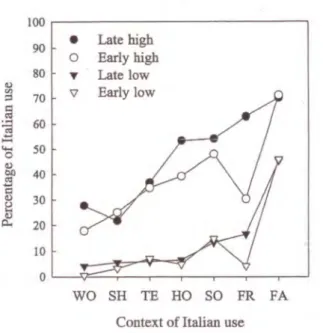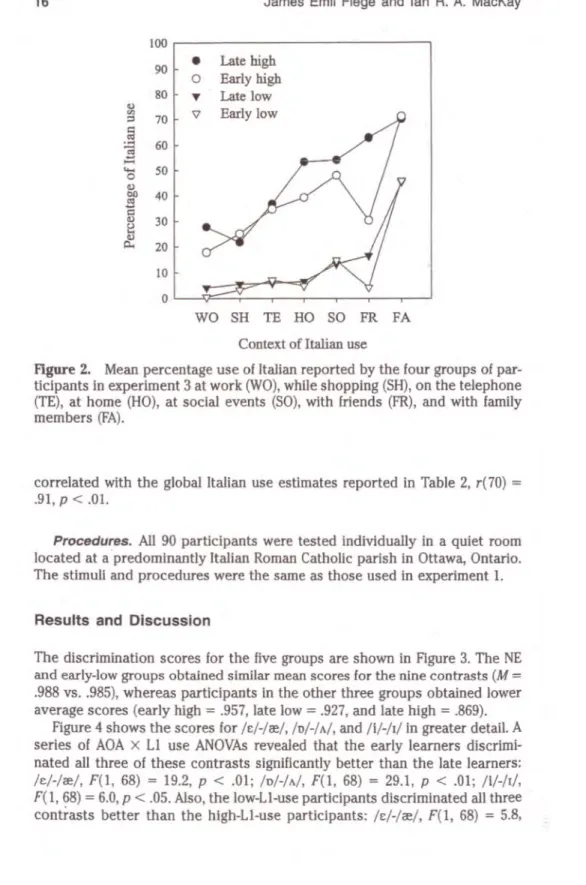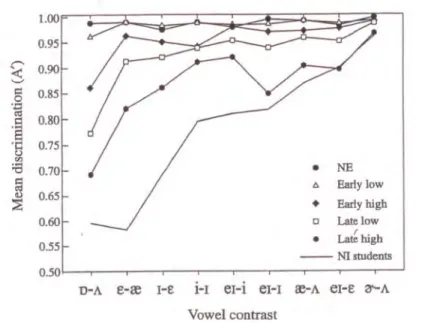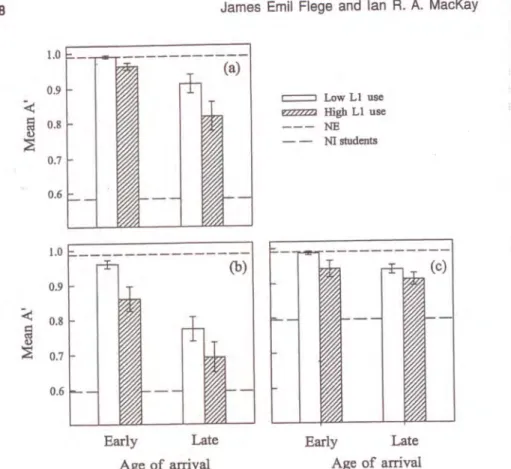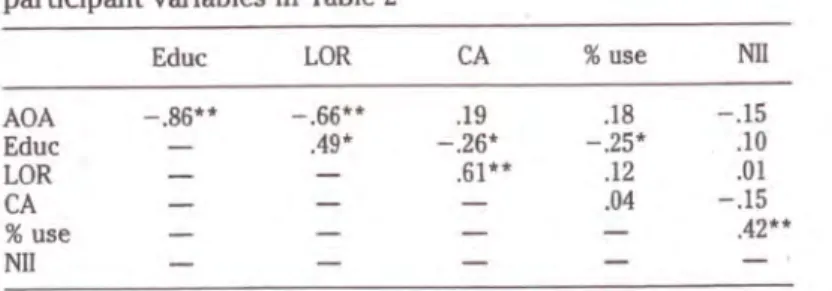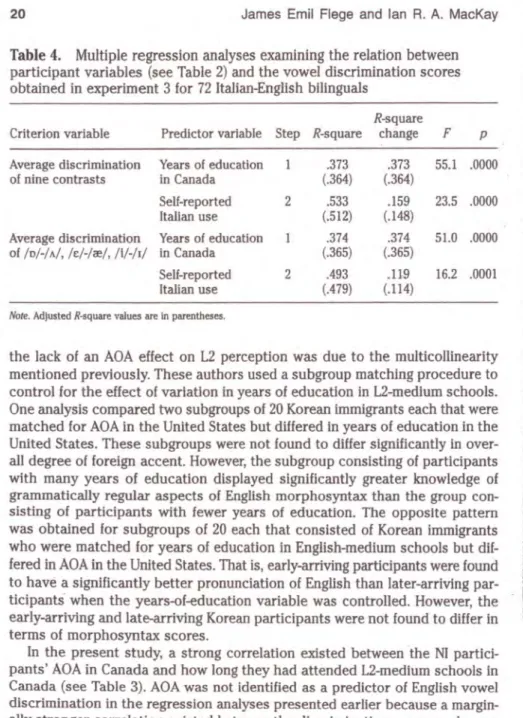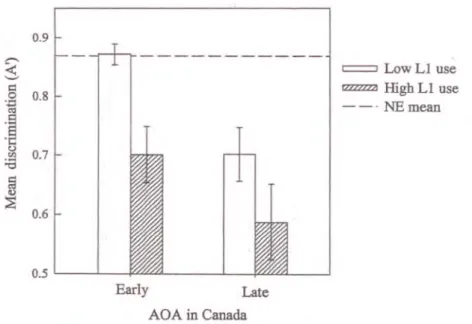PERCEIVING VOWELS IN A SECOND LANGUAGE
James Emil Flege
University of ALabama
Ian R. A. MacKay
University of Ottawa
This study examines the perception of English vowels by native speak- ers of Italian. In two preliminary experiments. Italian university stu- dents who had lived in Canada for 3 months were found to have difficulty discriminating In/-IA!. le/-/oo/. and /iI-/II because they often identified both members of each contrast as instances of a single Italian vowel. The participants in two other experiments. long-time residents of Canada. were assigned to groups based on their age of arrival in Canada from Italy (early vs. late) and percentage of first language (L 1) use (high L 1 use vs. low L 1 use). Experiment 3 focused on the discrimination of le/-IA!. Ic/-/ffi/. and /i/-/Il. and experiment 4 examined the discrimination of correct from incorrect realizations of /II and N. In both experiments. the early learners obtained higher discrimination scores than the late learners. and low-L 1-use partici- . pants obtained higher scores than high-L 1-use participants. Most important. the early learners who used Italian often (early high).
but not the early learners who used Italian ~eldom (early low). were found to differ from native speakers of Englfsh in perceiving English vowels. These results suggest two important conclusions regard- ing second language (L2) perceptual learning: Learning an L2 in childhood does not guarantee a nativelike perception of L2 vowels, nor does the establishment of a sound system for the L1 preclude a functionally nativelike perception of L2 vowels. Another important
This study was supported by grant DCOO257from the National institute of Dea1ness and Other Com- municative Disorders.The authors thank J. Prosperine and M. Pearse lor hetp locating participants, Fr. M. Brodeur 0151. Anthony's Church in Ottawa, Ontario, and all the partJclpants. The authors are grateful to D. Meador and T. Piske for help preparing the stimuli used in experiment 4. Anally, thanks are extended to K. Aoyama, S. Imal, K. Tsukada, T. Piske, and three anonymous SSLA reviewers for comments on an earlier version of this article.
Address correspondence to: J. E. F1ege, Division of Speech and Hearing Sciences, CH20, Room 119, 1530 Third Avenue South, Birmingham. AL 35294-2042; e-mail: [email protected].
2 James Emil Flege and Ian R. A. MacKay
finding is that. although the late learners generally perceived English vowels less accurately than the early learners, some perceived them accurately.
It is important to understand how the vowels of a second language (L2) are perceived. Differences in segmental perception between native and nonnative speakers may slow the processing of an L2 (Munro & Derwing, 1995; Schmid
&Yeni-Komshian, 1999) and may contribute to word-recognition difficulty (e.g., Bradlow & Pisoni, 1999; Mayo, Florentine, & Buus, 1997). It has also been hypothesized (e.g., Rochet, 1995) that native-nonnative differences in percep- tion may limit the accuracy with which L2 phonetic segments can be pro- duced. The aim of this study, therefore, is to provide a better understanding of L2 vowel perception. The study focuses on the question as to whether adults who begin learning their L2 in childhood can or cannot perceive L2 vowels in a nativelike fashion.
A number of studies have examined the production of L2 vowels by adults who were first exposed to their L2 either in childhood (early learners) or in late adolescence or early adulthood (late learners).These studies have shown that an influence of the first language (Ll) vowel system is often readily appar- ent in late learners' production of L2 vowels, especially in early stages of learning (lun &Cowie, 1994; Major, 1987; Munro, 1993). However, late learners typically produce L2 vowels more accurately as they gain experience in the L2, sometimes producing L2 vowels with formant frequency values that are intermediate to the values observed for monolingual speakers of the Ll and L2 (e.g., Flege &Hillenbrand, 1984). Experienced late learners have also been observed to produce certain L2 vowels accurately, especially when the L2 vow- els are located in a portion of vowel space that is not occupied by an Ll vowel (Bohn & Flege, 1992; Flege, 1987, 1992b; Ingram &Park, 1997). Previous research has shown that early learners produce L2 vowels more accurately than most late learners (Baker, Trofimovich, Mack, & FIege, 2002; Flege, 1992a; Munro, FIege, &MacKay, 1996) although they may differ from the native speakers of the target language in producing certain vowels if they continue using their Ll frequently (Flege, Schirru, &MacKay, 2003; Piske, FIege, MacKay, &Meador, 2002).
A similar pattern of results has been obtained in research examining the perception of L2 vowels. Gottfried (1984) found that native speakers of English who had studied French in the United States correctly identified naturally pro- duced French vowels less often than native French speakers (see also Ingram
& Park, 1997). The participants in a study by FIege, Bohn, and Jang (1997) identified the members of a synthetic "beat-to-bit" (Ji/-to-/I/) continuum that differed orthogonally in spectral quality and duration. Native English speak- ers based their judgments primarily on spectral quality, whereas many of the native Spimish late learners based their judgments exclusively on vowel dura-
tion. The results suggested that some native Spanish late learners failed to perceive the spectral difference between English /i/ and /II even though pre- vious research had shown that native Spanish adults can auditorily detect such differences (Flege, 1991; Flege, Munro, &Fox, 1994). However, 4 of the 20 late learners who were examined showed a nativelike use of spectral differ- ences in classifying the English vowels (see also Morrison, 2002).
Baker et al. (2002) examined the discrimination of English vowels by groups of Koreans who were matched for years of residence in the United States (M= 9 years) but differed in age of arrival (AOA,M =9 vs. 19 years) and percent- age Korean use (M=31%vs. 55%). The early learners discriminated English vowels better than the late learners but did not differ significantly from native English (NE) speakers. Similar results were obtained by Flege, MacKay, and Meador (1999), who examined the discrimination of English vowels by native speakers of Italian. The native Italian (N!) participants were selected based on their AOA in Canada from Italy and percentage Italian use. The participants in groups designated "early high" and "late high" used Italian relatively often but differed in AOA(M=7 vs. 19 years), whereas participants in "early low" and
"early high" groups were matched for AOA but differed in Italian use (M =8%
vs. 32%). Both groups of early learners (early low and early high) obtained higher discrimination scores than the late bilinguals but did not differ signif- icantly from either the NE group or one another.
Other studies have provided evidence that early learners differ from native speakers of the target L2 (or L2 native speakers, for short), however. Mack (1989) reported that French-English bilinguals living in the United States iden- tified significantly fewer members of a synthetic li/-/II continuum as /i/ than NE speakers. Four studies tested for differences between native Spanish learn- ers of Catalan and native speakers of Catalan. The early learners in these stud- ies were university students in Barcelona who had begun to learn Catalan by school age, were highly proficient in both Spanish and Catalan, and were said to use both languages frequently. Each study used a different technique to assess the p~rception of Catalan speech sounds. Pallier, Bosch, and Sebastian- Galles (1997) examined the identification and discrimination of vowels in a synthetic continuum. Pallier, Colome, and Sebasti.fu1-Galles (2001) used the rep- etition priming paradigm. Sebasthin-Galles and Soto-Faraco (1999) used a ver- sion of the gating paradigm. Bosch, Costa, and Sebastian-Galles (2000) employed . the "perceptual magnet" paradigm. All four studies examined Catalan lei and
lEI, and all four revealed differences between early learners and native speak- ers in the perception of these vowels.lFor example, the grouped lel-lel iden- tification function obtained by Pallier et aI. (1997) for native speakers of Catalan but not for early learners revealed a clear crossover from leito lei.
The results obtained for early learners in Barcelona suggested that an accu- rate perception of L2 vowels might be impossible following establishment of the L1 sound system. Sebastian-Galles and Soto-Faraco (1999, p. 120) inter- preted their findings to indicate a "lack of plasticity" in early learners and suggested that the malleability of the speech perception system might be lim-
4 James Emil Flege and Ian R. A. MacKay
ited "severely" by school age because exposure to the L1 exerts a "very strong constraint" on the "organization and acquisition of phonemic categories." Pal- lier et al. (1997, p. B14) concluded that even early and frequent exposure to an L2 might be insufficient to permit the learning of "two new phonetic cat- egories which overlap" a single Ll category. Bosch et al. (2000, pp. 215-216) inferred that the early learners continued to represent Catalan vowels as "for- eign" speech sounds for which "stable representations in long-term memory"
were not established.
CAN EARLY LEARNERS PERCEIVE L2 VOWELS ACCURATELY?
The basis for vowel perception differences between the early learners in Bar- celona and L2 native speakers is uncertain. The differences were probably not due to the passing of a critical period, at least not one ending at the age of 12 years (Scovel, 1988,2000) or 15 years (Patkowski, 1989).It seems unlikely that a critical period for L2 speech perception, should one exist, would occur prior to the completion of Ll speech perception development (see, e.g., Eisen- berg, Shannon, Martinez, Wygonski,&Boothroyd, 2000; Johnson, 2000; Walley
& Flege, 2000).
An explanation for the results obtained for early learners in Barcelona might be drawn from the native language magnet model, or NLM(e.g., Kuhl, 2000).
The primary aim of the NLMis to account for the transition from auditory to language-specific perceptual processing. The NLMproposes that perception of the acoustic properties of speech sounds is defined by early experience.
Infants perceptually sort segment-sized units into categories based on the recurrence of features they have detected in speech Input. This results in a language-specific mapping between the categories developed for Ll speech sounds and phonetic input. In support of this, Kuhl, Williams, Lacerda, Stevens, and Lindblom (1992) observed differences in the perception of vow- els by 6-month-old infants in the United States and Sweden.
Kuhl (2000, p. 11854) proposed that infants' perceptual mapping of ambi- ent language speech sounds creates a ·complex network, or filter, through which language is perceived." Perceptual attunement to Ll categories may later shape the perception of L2 speech sounds. Interference effects m'ight arise because of the difficulty inherent in functionally separating Ll and L2 map- pings (I.e., categories) or because a neural commitment to Ll category map- pings will later influence the processing of L2 speech sounds.
Support for this was provided by Iverson et al. (2003), who examined the perception of English
III
andIII
by NE adults and native Japanese adults in Tokyo. Participants rated the acoustic similarity of a grid of Ila! and Ila/ stimuli differing in the frequency of F2 and F3 transitions into the vowel. Multi- dimensional scaling analyses suggested that the perception of acoustic- phonetic. dimensions was shaped by attunement to the Ll phonetic system in a way that might be conceptualized as a "warping" of the phonetic space.Unlike NEparticipants, the native Japanese participants did not show a height- ened discrimination of stimuli straddling the English/1/-/1/ boundary, nor did they show evidence of a stretching or shrinking of the F3 dimension. The authors suggested that native speakers of Japanese develop perceptual maps that, although well suited for Japanese, may impede acquisition of the English
/1/-/1/ contrast. They also suggested that Japanese adults who do manage to establish new categories for English liquids might develop erroneous long- term memory representations in which variation in F3 frequency is given too little prominence.
Importantly, the NLM proposes that constraints on the perception of L2 speech sounds arise from prior experience, not a loss of neural plasticity.
Iverson et al. (2003) suggested that Ll Interference effects might be Kselt- reinforcing" for Japanese adults if, as the result of a warping/of the phonetic space, they fail to experience the same auditory distribution of F3 differences in English/1/ and
/II
tokens as do children who are learning English as an Ll.However,perceptual learning by adults remains possible, according to the NLM.
Kuhl (2000, p. 11855) suggested that the influence of prior experience might be minimal for children who learn two languages simultaneously in early child- hood if "two different mappings" are acquired for L1 and L2 speech sounds.
Adult L2 learners might circumvent L1 interference effects if they can recapit- ulate infants' experience of Ll speech-that is, if they manage to receive Kexaggerated acoustic cues, multiple instances by many talkers, and massed listening experience" (see also McCandliss, Fiez, Protopapas, Conway, &
McClelland, 2002; McClelland, Thomas, McCandliss,& Fiez, 1999).
Although the findings for early learners in Barcelona are straightforward, there is reason for caution in accepting the conclusion that an accurate per- ception of L2 vowels is impossible following establishment of the L1 sound system. First, It Is widely believed that children learn an L2 rapidly and well (see Snow, 1987, for review). Second, it has been established that early bilin- guals generally succeed better in producing and perceiving an L2 than late bilinguals do (see Flege, 1999, for review). If early bilinguals' capacity for per- ceptuallearning were severely limited, one wou,ld expect to observe little if any perceptual learning by late learners and, by~enslon, little improvement in production. However, the research previously reviewed indicated that adult L2 learners do make progress in learning to produce L2 vowels. Finally, con- clusions drawn from the Barcelona research run counter to models of speech acquisition such as the NLMand the speech learning model, or SLM.
The SLM(Flege, 1988, 1992a, 1995, 1999, 2002, 2003a) proposes that even adults retain the capacities used by infants and children to acquire their Ll' including the ability, in time, to perceive the properties of L2 speech sounds accurately and to establish new phonetic categories. However,· the SLM hypothesizes that the likelihood of category formation for L2 speech sounds depends on perceived cross-language phonetic distance and the state of devel- opment of L1 phonetic categories. More specifically, It predicts that the like- lihood of category formation for L2speech sounds increases as a function of
6 James Emil Flege and Ian R. A. MacKay
their perceived distance from the closest L1 speech sound. The SLMalso pre- dicts that, as L1phonetic categories develop through childhood and into ado- lescence, they will become more powerful attractors of L2speech sounds and thus become more likely to block the formation of new categories for L2speech sounds. In support of this, Baker et al. (2002) obtained evidence that the per- ceptual assimilation of English vowels by Korean vowels was stronger for Korean adults than children.
One possibility evaluated in this study is that the observed difference between early learners and native. speakers in Barcelona may not be gen- eralizable to all vowels encountered in an L2. It is generally agreed that the perception of L2 vowels will depend, at least initially, on their perceived rela- tionship to vowels in the L1 inventory (Best, 1995; Kuhl, 2000). For example, research has shown that L2vowels tend to be discriminated well if they map onto (I.e., are perceptually assimilated by) two different L1 vowels. A pair of L2vowels will be discriminated less accurately, however, if they are judged to be instances of a single L1 vowel (Best, Faber, &Levitt, 1996; Flege, Guion, Akahane-Yamada,&Downs-Pruitt, 1998).
Catalan lei and 1r.1may pose an especially difficult perceptual learning task for native speakers of Spanish. These vowels occur in a portion of vowel space that is occupied by a single Spanish vowel, lei. Bosch et al. (2000) described Spanish lei as having [e] and [r.] allophones and as occurring near the percep- tual boundary between Catalan lei and 1r./.The perceived relationship between Catalan lei and 1r.1and Spanish lei was not assessed. However, if Spanish speakers judge Catalan lei and 1r.1tokens to be equally good instances of Span- ish lei, then the perceptual assimilation model, or PAM(e.g., Best, 1995;Best, McRoberts, &Goodell, 2001) would predict poor discrimination of Catalan lei and 1r.1by Spanish learners of Catalan, regardless of their age of first expo- sure to Catalan.
Another possibility is that the results obtained for early learners in Barce- lona will not generalize to all early learners of an L2. Language-use patterns are known to influence performance in an L2 (e.g., Bahrick, Hall, Goggin, Bahrick,&Berger, 1994).Recent studies have shown that, compared to NIlearn- ers of English who continue to use their L1 often, those who seldom use it have a better overall pronunciation of English (Flege, Frieda,&Nozawa, 1997;
Piske, MacKay,&Flege, 2001), identify English consonants better (MacKay,Mea- dor,&Flege, 2001), and recognize more English words in noise (Meador, Flege,
&MacKay, 2000). The early bilinguals in Barcelona were said to use their L1 frequently (Pallier et aI., 1997, p. B11). It is therefore possible that early learn- ers who used Spanish infrequently might not have differed from native speak- ers of Catalan.
THE PRESENT STUDY
This study examined the perception of English vowels by native speakers of Italian. Standard Italian has fewer contrastive vowels (/i, e, r., a,:J,0, ul) than
English (Agard &DiPietro, 1964). If Italian children who learn English cannot establish new categories for English vowels, one would expect them (and a fortiori Italian adults) to have difficulty discriminating certain pairs of English vowels. For example, if NI speakers identify English /II and /i/ tokens as instances of Italian /i/, they should discriminate these English vowels less accu- rately than NE speakers (Best, 1995; Best et a!., 1996; Polka, 1995).
No previous study has examined the perceived relation between English and Italian vowels. The aim of the first two experiments, therefore, was to assess the perceptual assimilation of English vowels by Italian vowels and to determine which of nine English vowel contrasts would prove difficult for NI speakers to discriminate. The participants in experiments 1 and 2 were Italian university students who had resided in Canada for just 3 months. These exper- iments revealed that both members of the /i/-/Il, /DI-/A/, and /e/-/re/ con- trasts tended to be identified as instances of a single Italian vowel. These contrasts may, therefore, have posed the same kind of learning problem for Nllearners of English that Catalan /e/ and /e/ pose for native. Spanish learp- ers of Catalan.
Experiments 3 and 4 examined native speakers of Italian who were long- time residents of Canada. Half were early learners with an AOA ranging from 2 to 13 years, and half were late learners with an AOA ranging from 15 to 26 years. Experiment 3 focused on the categorial discrimination of /i/-/Il, /D/-/ A/, and /e/-/re/, and experiment 4 examined the perception of /i/ and /II using an error detection task. As expected (FIege, 1992a; FIege et al., 1999; Yamada, 1995), the late learners discriminated English vowels less accurately than the early learners. The primary question, however, was whether the early learners would differ from NE speakers. The early and late learners were subdivided accord- ing to percentage Italian use (low Ll use, 1-15%; high Ll use, 25-100%). Flege et al. did not observe a difference in English vowel discrimination for early learners differing in percentage Italian use. However, the difference between the early-low and early-high groups approached signific~ce (p =.08). Obtain- ing a significant Ll use effect was considered more likely in this study because the Ll use difference between the early-low and early-high groups was larger than in the previous study. If the early-high but not the early-low group were found to discriminate English vowels less accurately than the NE group, it would challenge the view that an accurate perception of L2 vowels is impos- sible following establishment of the Ll sound system. Another question addressed by experiment 3 was whether, as predicted by the SLM, some late learners would establish new categories for English vowels and discriminate English vowels as accurately as NE speakers.
EXPERIMENT 1
The purpose of this experiment was to examine the perception of English vow- els by NI university students who had recently arrived in Canada. Vowel per- ception was evaluated using an oddity discrimination test that has been used
8 James Emil Flege and Ian R. A. MacKay
in recent L2 research (Flege, 2003b; Flege et al., 1998, 1999; Guion, Flege, Akahane-Yamada,&Pruitt, 2000). The test was categorial in that each vowel category was represented by multiple natural tokens.
Method
Participants. Two groups of university students participated in Ottawa, Ontario. One group (3 males, 9 females) consisted of native speakers of Cana- dian English enrolled at the University of Ottawa. The other group (3 males, 9 females) consisted of native speakers of Italian. The NI students, who had the same age(M =22 years) and years of formal education (M =15 years) as the NE students, had all been living in Canada for 3 months at the time of testing.
They were enrolled in a special one-semester program at Carleton University as part of their training in translation at an Italian university. The Italian stu- dents reported having studied English in Italy for an average of 9 years (range=
3-15 years) beginning at an average age of12years (range=7-18 years). They came from a variety of regions in Italy (3 from Puglia, 3 Molise, 2 Sicilia, 2 Abruzzo, 1Umbria, 1 Piemonte, 1 Lombardia) and so were likely to have learned somewhat different Ll vowels as children (e.g., Canepari, 1986).
Stimuli. The perceptual stimuli consisted of consonant-voweI-consonant (CVC)English words produced by adult native speakers of Canadian English (4 male, 1 female). The words were formed by inserting the vowels Iii, /II, le'/, lei, lre/, I AI, andI'(J-Iinto aIb_dl context and the vowels /DI andI AI into aIk_dl context. Vowels in the Ib_dl context (e.g.,bead, bid) were used to test the /i/-/Il, /II-/e/, /e'/-/e/, /e'/-li/, /e/-/re/, /e'/-/Il, /rel-/A/, and /'3'/-/ A/ con- trasts, and vowels in the Ik_d/ context (e.g.,cod, cud) were used to test the
/D/-I AI contrast.
The words were digitized (22.05 kHz) and then normalized for peak inten- sity. The design required that there be within-category variation in the tokens representing each vowel category of interest. As expected, acoustic analyses revealed higher formant frequency values in vowels spoken by the female talker than by the four male talkers and also differences in the duration, midpoint formant frequency values, and amount of formant movement among the five tokens of each vowel. A preliminary auditory evaluation revealed that despite the existence of considerable within-category variation, NE-speaking listeners judged the vowels in each of the CVCstimuli to be good instances of their intended categories.
Procedure. All participants were tested individually in a quiet room using a notebook computer. The Italian students were tested on the Carleton Uni- versity campus, whereas the NE students were tested at the University of Ottawa. Instructions were administered in English to all participants in this and subsequent experiments.
The three CVCstimuli presented on each trial were always produced by three different talkers. A total of 20 trials tested each of the nine contrasts.
Half the trials, called change trials (e.g., /bit/ /bIt/ /bit/), contained an odd item out that occurred with near-equal frequency in all three possible serial positions. The remaining trials, calledno-c~ange trials(e.g.,/be't/ /be't/ /be't/), contained three physically different instances of a single vowel category. The interstimulus interval between the three stimuli in all trials was 1.2 s.
The decision to include both change and no-change trials was motivated by the widely held view (e.g., Francis & Nusbaum, 2002; Guenther, Husain, Cohen, &Shinn-Cunningham, 1999; Kuhl, 1980) that the formation of a pho- netic category will increase sensitivity to differences between members of the new category and other categories but lead to a decrease in sensitivity to differences among,members of the new category. The change trials tested the participants' ability to distinguish vowels drawn from two different catego- ries. The vowels in no-change trials differed audibly but not in a phonetically relevant manner. The no-change trials therefore tested the participants' abil- ity to ignore audible but phonetically irrelevant within-<:ategoryvariation.
The stimuli were presented via headphones at a self-selected comfortable volumelevel.2Feedback was provided during a 20-item practice session using nontest stimuli (/but/ and /bot/ tokens) before the experiment began. Feed- back was not provided during the experiment. However, five extra trials were presented for practice at the beginning of the experiment. The participants were told to focus their attention on the vowels in the three evc words pre- sented on each trial. They were instructed to click a button marked "1," "2,"
or "3" to indicate the serial position of the odd item out, if they heard one.
They were told to click a fourth button marked "same" if they heard three different instances of one vowel. A trial could be replayed, but responses could not be changed once given.
An A' score was calculated for each contrast to reduce the possible effect of response bias. The A' scores were based on the proportion ofhits andfalse alarms. Hits were defined as the correct selection of the odd item out in change trials (maximum= 10 per contrast). False alarms were defined as the incor- rect selection of an odd item out in no-change trials (maximum=10 per con- trast).3 An A' score of 1.000 indicated perfect sensitivity to a vowel contrast (i.e., correct responses to all 10 change and all 10 no-change trials). A score of .500 represented a theoretically defined chance level of response (see Snodgrass, Levy-Berger,&Haydon, 1985), that is, a lack of sensitivity.
Results and Discussion
The NE students' scores were higher (M = .996,SD=.006) than the Nl stu- dents' scores (M = .780,SD= .061).However, as shown in Figure 1, the size of differences between the two groups varied as a function of vowel contrast.
The NE students obtained perfect scores for/?1-/-/ A/ and near-perfect scores
10
1.00
;-0. 0.950.90
<
';;'0 0.85 .... 0.80~ '8Q 0.75 'r:: '"(,) 0.70
:a
;j
0.65<1.)
:::E 0.60
0.550.50
James Emil Flege and Ian R. A. MacKay
• NEstudents o NI students
e-re D-A I-e 1-1 el-i el-I re-A el-e '<f'-A Vowel contrast
Figure 1. Mean discrimination (A') of nine English vowel contrasts by the native English (NE)and native Italian (NI)students in experiment I. The error bars bracket ±1.0SE.
for the remaining eight English vowel contrasts. Accordingly, the/3'-/-/1'./ scores were excluded from the group (NI vs. NE) by contrast (eight levels) ANaYA examining the discrimination scores. This analysis yielded significant main effects of group, F(l, 22)=151.0,P < .01, and contrast, F(7, 154)=10.3,P <
.01, and a significant two-way interaction, F(7, 154)=10.2,p
<
.01.The two-way interaction was explored by a series of independent (-tests (each withdf =22) testing the simple effect of group for each contrast. These tests revealed that the Italian students obtained significantly lower scores than the NE students for each of the eight contrasts examined in the ANaYA(Bon- ferroni adjusted p
<
.01). A one-sample (-test was conducted to evaluate the Nl students' discrimination of the ninth contrast examined,/3'-/-/1'./. Their scores for/3'-/-/1'./ were significantly lower than the mean score of 1.000 obtained for the NE students, (=2.54,p = .019.The Italian students discriminated all nine English contrasts more poorly than the NE students. A series of one-sample (-tests was carried out to deter- . mine how many contrasts were discriminated at a significantly above-chance rate. The Italian students' scores were compared to .500, the value indicating a theoretical lack of sensitivity (Snodgrass et al., 1985). The students' scores significantly exceeded .500 (Bonferroni adjustedp < .05) for all contrasts except the two receiving the lowest discrimination scores (fe/-/re/, ( = 1.84;
/D/-/A/, (=1.88). This suggested that the Italian students were at least par- tially aware of differences between certain pairs of English vowels. The rela-
tive difficulty of the nine English contrasts was explored further in a one-way
ANOYA, which yielded a significant effect of contrast, F(8, 88)=13.7,P
<
.Ol.Tukey's HSD procedure indicated that the Italian students obtained signifi- cantly lower scores for both /e/-/re/ and ID/-I AI than for six other contrasts (fi/-/I/, /el/-/i/, /el/-/I/, /re/-/AI, /e'/-/e/, /<1"1-/A/) ,for/I/-/e/ than lor three other contrasts (frel-/ A/, /el/-/e/, /<1"1-/A/), and for/iI-/r/ than /<1"/-1A/ (p
<
.05).In summary, Italian students who lived in Canada for 3 months discrimi- nated nine pairs of English vowels less accurately than age-matched NE stu- dents. However, the English vowel contrasts varied considerably in difficulty.
The Italian students discriminated seven of the nine contrasts that were exam- ined at significantly above-chance rates. They obtained significantly lower scores for/c/-/re/, /D/-/AI, /I/-/e/, and/i/-/r/ than for one or more of the other contrasts examined. The aim of the next experiment was to h'illp account for differences between the nine contrasts.
EXPERIMENT 2
The aim of this experiment was to assess the perceived relation between the English vowel stimuli used in experiment 1 and Italian vowels. Research within the framework of the PAM(Best, 1995) suggests that contrastive L2 vowels that are identified as instances of two different L1 vowel categories will be relatively easy for L2 learners to discriminate. Conversely, the PAMpredicts less accurate discrimination of contrastive L2 vowels that are identified as instances of a single L1 vowel category.
Procedure
The ItalIan students (described previously) partIcipated immediately after com- pleting experiment 1. The eyC stimuli from experiment 1, along with booed (fu/) and bode (fo/) tokens spoken by the same five NE speakers, were pre- sented randomly via headphones. Responses were written on a specially pre- pared answer sheet rather than recorded by the potebook computer used for testing. This is because two different types of judgments were needed for each vowel stimulus. Each stimulus was aurally presented twice in a row. When hearing a stimulus for the first time, the participants classified its vowel as Italian /ii, lei,/e/, /a/,101,hi, or lu/.4 Following the second presentation, the participants rated the stimulus vowel for degree of similarity to the Italian vowel just selected using a scale that ranged from 1 (very different) to 5 (very similar). The participants were required to give both a classification response and a goodness-of-fit rating before proceeding to the next trial.
No training was provided for either the classification or rating task. How- ever, we were concerned that differences in the participants' L1 vowel sys- tems might influence the results. For example, distinctions between lei-lei and/01-/':)1are taught in Italian elementary schools because they do not exist
12 James Emil Flege and Ian R. A. MacKay
in certain varieties or dialects of Italian.As a precaution, the participants were given a written list of Italian keywords containing the seven vowels of stan- dard Italian before the experiment began. They were asked to repeat the key- words aloud and pay special attention to the distinction between lei and lei and between 101and I'J/. One of the 12Italian students reported that these distinctions do not exist in her native dialect of Italian.
Results and Discussion
Table 1shows the percentage of times that the English vowel stimuli were·
identified as instances of each Italian vowel category. The percentages in ital- ics indicate the modal classification of each English vowel.. Both vowels in three contrasts received the same modal classification: Englishleiandlcelas Italian lei; 101 and 111.1as Italian la/;and Iii and /r/ as Italian Ii!.However, different modal classifications were obtained for the English vowels compris- ing the remaining six English vowel contrasts. Table 1also shows, in paren- theses, the average ratings assigned to the stimuli that were classified in terms of each Italian vowel category. The most notable aspect of these data is that the EnglishI<Y-I stimuli received much lower goodness-of-flt ratings than the other English vowel stimuli, especially Ii!andlu/.
A question of interest was whether the perceptual assimilation data could provide an explanation as to why certain English vowels were more difficult than others for the Italian students to discriminate in experiment 1.To address
Table 1. Classification of the English vowel stimuli as one of seven Italian vowels in experiment 1
Meanpercentageof classification(goodness-of-fitrating) Stimulus
iii
leI1r.1 lal101I'JI lul
Ibit/
87(4.2) 8 (3.2) 5(4.3)
/bIt/
65(2.9) 35(4.0)
/be't/
8 (2.8) 62(3.3)30 (3.5)
/br.t/
-
47(3.6)53(3.8) Ibret/
-
10(3.2)15(2.6)75(3.8)
/bAt/ 93(3.7)3(2.0)
-- - - -
/b<1-t/ Ilrod/ 63(1.6)15(1.6)18(1.8)
-- -
47(3.4)20 (3. 7)33(4.1) lkAd/
-- -
68(3.4)25(3.3)7(4.0) Ibot/
- - -
3(4.5) 75(3.6)22 (3.5)
/but/ 95(4.2)3(4.0)
-- - - -
Note. Percentages less than 2% are not shown. The goodness-of-flt ratings ranged /rom 1 (very different) to 5 (very
similar). The values in parentheses are mean goodness-of-{It ratings.
this question, classification overlap scores were computed for each contrast.
. The computation can be illustrated as follows. The Italian students classified the English /e/ and /re/ tokens as Italian /e/ in 47% and 10%of instances, respectively. This gave a 10%overlap in use of the Italian /e/ category. The /e/ and /re/ tokens were classified as Italian /e/ in 53%and 75%of instances, giving a 53%overlap in use of the /e/ category. The two partial overlap scoreS yielded a score of 63% for the /e/-/re/ contrast.
There was a high degree of overlap for three of the four English vowel contrasts that were most difficult for the Italian students to discriminate in experiment 1 (viz., /e/-/re/, /0/-/AI, /i/-frl). A single Italian vowel was used in 63% of instances to classify both the English /e/ and /re/ tokens, in 74% of instances to classify both the English /0/ and /A/ tokens, and in 72% of instances to classify both the English
iii
and /II tokens. Conver,sely,there was little classification overlap for two of the three contrasts that were discrimi- nated most accurately by the Italian students (viz., /A/-/re/ and/<r-/-/AI). Spe- cifically, a single Italian vowel was used in only 15%of instances to classify both /A/ and /re/, and the same Italian vowel was never used to classify bothI<r-/ and /A/.
These results are consistent with predictions generated by the PAM(Best, 1995).However, the results for two other contrasts diverged from the general pattern just described. The high classification overlap score computed for lel/-/e/ (viz., 87%) led to the expectation of poor discrimination. However, the Italian students discriminated /el/-/e/ much better than the three other con- trasts receiving high classification overlap scores (viz., /el-/re/, /0/-/ A/, and Ii/-frl). An inspection of the classifications given by individual students pro- vided some insight into this anomaly. When considered on an individual basis, the overlap of Italian vowel categories used to classify /e'/-/e/ averaged only
40%.
The results for fr/-/e/ also diverged from the general pattern. The rela- tively low classification overlap score computed for /II-/e/ (viz., 35%) led to the expectation of relatively good discrimination. However, /II-/e/ received lower discrimination scores than all but two other contrasts (viz.,/e/-/re/ and In/-/AI).The difficulty of /II-/e/ might be explainef! in part by considering the acoustic specification of these vowels. Most vowels that are adjacent to one another in the English vowel space differ in terms of midpoint formant fre- quency values, duration, and formant movement patterns. However, English
/II and /e/ differ relatively little in terms of their midpoint formant frequen- cies and duration and do not show a differing pattern of formant movement (Hillenbrand, Clark,& Nearey, 2001). This might explain why NE-speaking lis- teners sometimes misidentify English /II and /e/ tokens that have been pro- duced by other NEspeakers (see Flege, 1988,for review). The results obtained here for /II-/e/ suggest indirectly, therefore, that nonnative discrimination of L2vowels may' depend on more than just cross-language patterns of percep- tual assimilation.
14
EXPERIMENT 3
James Emil Flege and Ian R. A. MacKay
This experiment examined discrimination of English vowels by long-time NI residents of Canada using the stimuli and procedures from experiment 1. Analy- ses focused on the /e/-/re/, /0/-/1./, and /i/-/r/ contrasts, which showed a single-<:ategory perceptual assimilation pattern in experiment 2. The PAM(Best, 1995) predicts that contrasts of this type will be difficult for L2 learners to discriminate.
Method
Participants. Eighteen NE and 72 NI speakers participated. The NI partici- pants were required to have been born in Italy and have immigrated to Can- ada between the ages of 2 and 13 years (early L2 learners) or 15 and 26 years (late L2 learners). They also had to report using Italian between 1% and 15%
(low L1 use) or between 25% and 100% (high L1 use) of the time. Length of residence (LOR) in Canada was not used as a selection criterion. However, all but two of the 72 NI participants had lived in Canada for more than 10 years, and all but three had lived there for more than 20 years.
The NI participants were assigned to one of four groups of 18 each based on their AOA in Canada and self-reported percentage use of Italian. The early learners who reported using Italian relatively seldom and often were desig- nated the early-low and early-high groups, respectively. The late learners who reported using Italian seldom and often were designated the late-low and late- high groups, respectively. Characteristics of the four groups are summarized in Table 2. The NI participants were born in one of 13 Italian regions (24 in Abruzzo, 12 Calabria, 8 Sicilia, 7 Veneto, 6 Campania, 4 Basilicata, 3 Lazio, 2 Friuli, 2 Puglia, 1 Lombardia, 1 Marche, 1 Piemonte, 1 Toscana). Place of birth did not vary systematically across the four groups. The age of the NE speak- ers was comparable (M =50,SD=5) to that of the four NI groups. None of the 90 participants reported a history of auditory disorder, and all passed a pure-tone hearing screening at octave frequencies between 500 and 4,000 Hz (re: 35 dB HL).
The Language Background Questionnaire (LBQ) shown in Appendix A was administered to the NI participants before testing began. The experimenter read each question and recorded all answers to prevent variation in reading ability from influencing the results obtained. Analysis of the LBQ revealed that the early learners had received substantially more education in Canada than in Italy (M =12.6 vs. 2.2 years), whereas the late learners had received sub- stantially less education in Canada than in Italy (M =1.7 vs. 9.0 years). Infor- mal interactions with the participants revealed that they had received little, if any, exposure to English in Italy before arriving in Canada.
The NI participants were asked to estimate their percentage use of Italian in the 5 years, 5 months, and 5 weeks prior to testing. The three estimates
Table 2.NENote.CA ~ chronological age In years; AOA ~ age of arrival In Canada In years; %use ~ self-reported percentageLearner groupsuse
were averaged in Table 2 because they were highly correlated (p
<
.001). Par- ticipants in the early-low and late-low groups reported using Italian 8% of the time on the average, whereas those in the early-high and late-high groups reported using Italian 48% of the time. The AOA of the early and late learners averaged 8 and 20 years, respectively. An ANOVArevealed that the low-Ll-use and high-Ll-use participants did not differ significantly according to ADA, F(1, 68)=0.7, p>
.10. Another ANOYArevealed that the late learners used Italian more than the early learners, F(1, 68)=7.3,P<
.01. However, AOA and Ll use did not interact significantly in an ANOVAexamining percentage Italian use, F(1, 68)=2.45,p>
.10..The NI participants' Ll use estimates appear to have been valid and reli- able. They were asked to name the persons with whom they spoke Italian.
The number 'of named interlocutors was examined in a two-way ANOVA.Par- ticipants assigned to the high-Ll-use groups named significantly more per- sons than those assigned to the low-Ll~use groups, F(1, 68)= 34.1,p
<
.01.However, the number of persons named by participants in the early and late groups did not differ significantly, F(1,68) =0.3,p
>
.10, nor did the AOAxL1 Use interaction reach significance, F(1, 68)=0.27,p > .10.
In addition to providing global percentage Italian use estimates, the NI par- ticipants were also asked to indicate their percentage Italian use in a variety of contexts (at work, while shopping, on the telephone, at home, in social sit- uations, with friends, and with family members). The average contextualized estimates given by the four NI groups are shown in Figure 2. These findings suggest that participants in the early-low and late-low groups used Italian almost exclusively with family members. An average of the contextualized esti- mates was computed for each Nl participant. These average estimates were
16 James Emil Flege and Ian R. A. MacKay
100
Late high
•
~~
0
Early high
80
Late low.•.
<1) Early low
'" ::3 70 \1
a :.::1
60 .;s0'" ...••...••...<1)00<1)~ 403050
8
~<1) 20100 WO TESH HOFRFASO Context of Italian use
Figure 2. Mean percentage use of Italian reported by the four groups of par- ticipants in experiment 3 at work (WO),while shopping (5H),on the telephone (TE), at home (HO), at social events (SO),with friends (FR), and with family members (FA).
correlated with the global Italian use estimates reported in Table 2,r(70) =
.91, P
<
.01.Procedures. All 90 participants were tested individually in a quiet room located at a"predominantly Italian Roman Catholic parish in Ottawa, Ontario.
The stimuli and procedures were the same as those used in experiment 1.
Results and Discussion
The discrimination scores for the five groups are shown in Figure 3. The NE and early-low groups obtained similar mean scores for the nine contrasts (M = .988 vs.. 985), whereas participants in the other three groups obtained lower average scores (early high = .957, late low = .927, and late high = .869).
Figure 4 shows the scores for /e/-/re/, /O/-/A/, and /i/-/I/ in greater detail. A series of AOAX Ll use ANOVAsrevealed that the early learners discrimi- nated all three of these contrasts significantly better than the late learners:
/e/-/re/, F(1, 68) = 19.2,P
<
.01;/O/-/A/, F(1, 68) = 29.1,P<
.01;/iI-/rI, F( 1, 68)=6.0,p < .05. Also, the low-Ll-use participants discriminated all threecontrasts better than the high-Ll-use participants: /e/-/re/, F(1, 68)= 5.8,
L2 Vowel Perception
1.00 .-.. 0.95
~0 '.0•...-~= 0.850.800.90
'§ .t::
u :.s'" 0.750.70
J •
NE
a
£>
Early low
(L)
0.65
:::E Early high
•
0.60
Late low 0 0.55
Lat6 high -- NI students 0.50
17
D-A e-re I-e I-I eI-l eI-I re-A eI-e '3'-A Vowel contrast
Figure 3. Mean discrimination of nine English vowel contrasts by native English (NE) speakers and four native Italian (NI) groups in experiment 3. Scores for the NI students in experiment 1 are included for comparison.
p < .05;/O/-/A/, F(1, 68) = 13.1,p < .01; Ii/-N, F(1, 68) = 5.1, p < .05. No significant AOAX Ll Use interactions were obtained: /E/-/re/, F( 1, 68) =1.8, p> .10;/O/-/A/, F(l, 68)=0.1,P
>
.10;Ii/-N, F(1, 68)=0.3, p>
.10.Differences between the NE group and the four NI groups were evaluated in a series of one-way ANOYAs. The effect of group was significant for all three contrasts: /E/-/re/, F(4, 85) =10.2,p
<
.01; /D/-/A/, F(4, 85) = 17.5,p<
.01;/i/-N, F(4, 85) =5.5,p
<
.01. The four NI groups were compared to the NE group in a series oft-tests (df=34) to evaluate native versus nonnative differ- ences. PartiCipants in the late-low, late-high, and early-high groups, but not -those in the early-low group, obtained lower scOres than the NE group for/0/-/ A/(Bonferroni adjusted p < .05). Participants in the late-low and late-high groups obtained lower scores than the NE group for /e/-/re/ (p
<
.05). Thedifference between the early-high and NE groups for /e/-/re/ was marginally significant (p = .06), but the difference between the early-low and NE groups was nonsignificant (p > .10). Only the late-low and late-high groups differed . significantly from the NE group forIi/-N (p
<
.05).The scores obtained for each of the 72 NI participants for /E/-/re/, /01-/A/, and Ii/-N were evaluated to determine if they fell within ±2.0 SDs of the NE groups' mean scores. The late learners met the 2-SD criterion in 32% of 216 -(3 contrasts X 72) possible instances. The early learners met the 2-SD cri- terion in 81% of instances.s Chi-square tests revealed that more early than -late learners met the criterion for each contrast: /O/-/A/, X2(1) =10.9,p
<
.05;l~~ _
18
1.0 0.9
<: :::Ed)~ 0.80.7 0.6
0.9
<: 0.8
~d) ::E 0.7
0.6
Early Late
Age of arrival
James Emil Flege and Ian R. A. MacKay
c:=:J Low L 1 use
I2ZZZZZI High Ll use
NE - - NI students
Early Late
Age of arrival
Figure 4. Mean discrimination of (a) /e/-/ce/, (b)/U/-/A/, and (c) /iI-/l/ by four native Italian (NI) groups in experiment 3. The error bars bracket ±1.0SE.
The reference lines show the mean scores obtained by the native English (NE) and N1students tested in experiment 1.
/e/-/ce/, x2(1) =11.0,p < .05; /i/-N, x2(1) =3.8,p < .05. To obtain a high discrimination score, participants had to correctly choose the odd item out in change trials and also ignore phonetically irrelevant but auditorily accessi- ble within-category differences (e.g., the gender of the talker) in no-change trials. These findings therefore support the SLMhypothesis that, although indi- viduals of all ages retain the capacity for category formation, early L2 learn- ers are more likely than late L2 learners to establish new categories for L2 speech sounds.
Multiple Regression Analyses. Exploratory multiple regression analyses were run to examine the relation between the six participant variables shown in Table 2 and vowel discrimination. The analyses were necessarily explor- atory'because, as expected fmm previous research (e.g., Bahrick et al., 1994;
Flege, 1998;Yeni-Komshian,Flege,&Liu,2000), the participant variables were intercorrelated.
As summarized in Table 3, there was a strong correlation between the bilin- guals' AOAin Canada and how many years of education they had received in English-medium schools in Canada. Allparticipants who arrived in Canada as children were soon enrolled in school, whereas many later-arriving partici- pants received no education inCanada.6 The years-of-education variable, in turn, was correlated significantly with other variables. A relativelylarge amount of education was associated with a relatively long LORin Canada, a relatively young chronological age at the time of testing, and a relatively low self- estimated percentage' use of Italian. Not surprisingly, the higher the self- estimates of percentage Italian use, the more specific individuals the bilingual participants tended to name as persons with whom they spoke4talian. Finally, a relatively lengthy residence in Canada was associated with a relatively early arrival in Canada and a relatively old age at the time of testing.
Two forward, step-wise multiple regression analyses examined the relation between the six participant variables (in Table 2) and vowel discrimination.
The criterion variables were the average discrimination scores obtained for all nine English vowels contrasts and the average score for just the three con- trasts of special interest. As summarized in Table4,years of education in Can- ada accounted for 37%of the variance in the overall discrimination scores at step 1, and percentage Italian use accounted for an additional 16%of the vari- ance at step 2. Years of education accounted for 37% of the variance in the scores obtained for ID/-IAI, le/-/re/, and Ii/-III, and percentage Italian use accounted for an additional 12%of the variance.
The failure of AOAto emerge as a significant predictor of vowel discrimi- nation in either analysis might seem surprising, given the focus on the age of L2 learning in so much second language acquisition research. The results obtained by Flege, Yeni-Komshian,and Liu (1999) suggest the possibility that
Table 3. Simple Pearson correlations between the participant variables in Table 2 ;
EducLORCA
%
useNIlAOA
- .86**-.66**.18.19 -.15 Educ
-
-.26*.49*-.25*.10 LOR
- -
.61**.12 .01 CA
-- -
-.15.04
%
use- - - -
.42**
NIl
Note. AOA=age of arrival In Canada In years; Educ =years of education In Canada In years;
LOR=length of residence in Canada In years; CA=chronological age In years; %use =self- reported percentage use of Italian; NIl=number of Interlocutors with whom ltaHan was used.
For each correlation, df=70.
'p <.05.up<.01.
